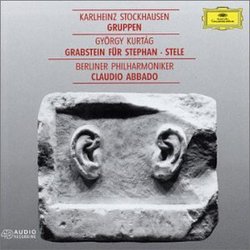Somewhat infuriating, but Kurtag fans will probably need to
Christopher Culver | 07/06/2007
(2 out of 5 stars)
"In the mid-1990s Deutsche Grammophon boasted of their sound quality by advertising their stereo CDs with not a little hyperbole as wonders of "4D Sound". Karlheinz Stockhausen's "Gruppen" seems like one of the best pieces to choose to show off how your recording system faithfully reproduces the original space, and the disc is rounded off by two orchestral pieces by Gyorgy Kurtag.
"Gruppen" for three orchestras (1955-57) is probably the greatest thing Stockhausen has ever written. The three orchestras are placed to the left, centre, and right of the audience respectively and exploits this spatial separation by having themes thrown from orchestra to orchestra, making it seem like the very sound is moving. Though written at the height of 1950s serialism, it's a light and airy piece that any audiences but the "classical music stopped with Brahms" conservatives are sure to enjoy. However, in spite of the best efforts of studio engineers, this piece simply doesn't work in a stereo downmix. A 5.1 surround version is desparately needed, and one wonders why Stockhausen-Verlag at least hasn't provided this yet. Furthermore, this performance is filled with misreadings of the score. Compare it to any of the other recordings out there (Boulez et al., Rattle et al., and the definitive recording from Stockhausen himself) and you'll spot a plethora of mistakes.
Gyorgy Kurtag is one of the most fascinating figures of the 20th century, with a unique blend of dark Bartokian sonorities and Webern-like brevity. Though his oeuvre slowly but steadily proceded from an opus number one string quartet in the late 1950s, he arrived on the international stage only when Pierre Boulez took up his music in the early 1980s, when the composer was nearly sixty. Most of Kurtag on disc, however, is for soloists or small ensembles, and this disc finally brought his orchestral music to home listeners.
Like the Stockhausen, Kurtag's "Gravestone for Stephen" op. 15c (1989) exploits the performance space by widely dispersing the players. It is the most stripped down piece I've ever heard from the composer. For most of its 9-minute length a guitar plays ascending scales at very low dynamic with the slightest of accompaniment by strings at even lower dynamics. Only at the midpoint do we get a few sad calls from the brass, before the music returns to the guitar and strings. Were the piece not written to commemorate the dead--the husband of Marianne Stein, the French psychologist who led Kurtag out of compositional crisis in the 1950--the limited musical material would seem as fluffy and insubstantial as the typical output of Rautavaara. Its anguished tones do move the listener somewhat, however.
The more ambitious "Stele" op. 33 (1994) is written for large orchestra in three movements, though at not much over ten minutes long it continues the composer's tendency to think short. The first movement consists of soft microtonal writing with prominent winds. The second begins with a buzzing, aleatoric-sounding soundscape reminiscent of Lutoslawski's second symphony before exploring various portions of the orchestra and then fading out with soft strings. The third movement is a slow ostinato on low instruments. It's an impressive exploitation of the possibilities of a large orchestra, though somewhat directionless.
Though I enjoy "Grabstein fuer Stephan" and "Stelae", especially the latter, I find Kurtag to be more impressive in the chamber music-- especially the string quartets--and piano solo genres. But that could be due to Abbado's reading of the pieces, which are untrustworthy. Watching Abbado prepare the pieces under Kurtag's supervision on the documentary The Matchstick Man documentary, I got the impression that Abbado just didn't really understand what he was doing. "Grabstein fuer Stephan" has been recorded on a Col Legno disc, where Peter Eotvos conducts, and I'm going to need to track that down.
Besides the lame reading of "Gruppen" and the untrustworthiness of the "Kurtag" performances, another objectionable thing about this disc is that it contains only 44 minutes of music. Could nothing else be found to fill it out? All in all, I give the disc two stars, but since Kurtag's orchestral works are difficult to find in recording, fans of that composer are probably going to make do with this disc anyway, and that hurts. If you are looking for an introduction to Kurtag, get theArditti Quartet performance of the string quartets. Likewise, encountering Stockhausen here for the first here would be disastrous. Lovers of modernism need to get to grips with Stockhausen's work at least for its historical importance if not the pure enjoyment in it, but as much as it's a pain in the neck to order, the definitive discs from Stockhausen-Verlag are the way to do it."


 Track Listings (5) - Disc #1
Track Listings (5) - Disc #1